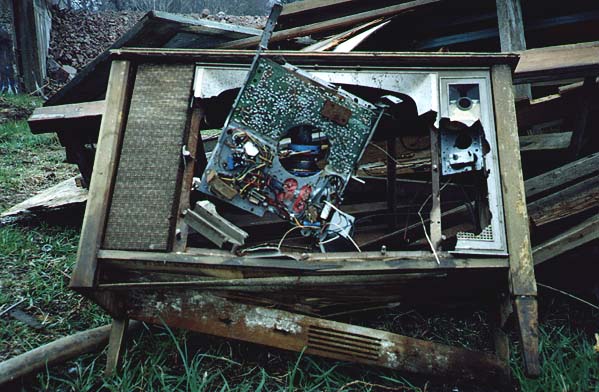Environmental Protection: Two Stories
I found two good blog postings about the state of environmental protection, focusing on two issues that show the difference that a little effective media attention can make in capturing the public's imagination.
The Nation's editor, Katrina vanden Heuvel, posts this piece entitled Sweet Victory: Waging War on Emissions, which implies that America is finally coming around on global warming. She points to the opening week's box office success of An Inconvenient Truth as solid evidence. Its first weekend didn't yield the kind of cash drawn by Nacho Libre or The Fast and Furious XXXIV but most commentators are impressed by the receipts. A Blogger on Treehugger says, "We don't expect a film based on a slide presentation to outdo Hollywood's summer blockbusters at the box office, but we're happy to see that An Inconvenient Truth is doing well so far."
Global warming expert Jim Hansen, in The New York Review of Books asks, "Is it possible for a single book on global warming to convince the public, as Rachel Carson's Silent Spring did for the dangers of DDT?" and then notes that while Gore's past attempts to stir the public about global warming "subjected him to ridicule from other politicians and cost him votes,
Makes you feel optimistic, no?
The other topic does not boast the benefit of having a large scale media event, involving a phoenix-like former presidential candidate buttressing its place in the public attention.
Mother Jones dot net features this piece titled "The Cost of Superfund Neglect."

You don't see protests like this anymore.
Flip over for a nice primer on Superfund history, as author Bradford Plummer says it much more succinctly than a certain former law student ever did. Even still, I defer to that former student's overview of the Comprehensive Environmental Response Compensation and Liability Act, affectionately known as the Superfund Law:

Love-ly Landscaping …
Plummer recounts the successful clandestine effort by the 1990s Republican-led Congress and Bush Administration to systematically undercut the law's liability enforcement scheme and underfund the money required to clean-up "orphaned" toxic waste dumps where the public health is endangered. However, he notes the more menacing news that:
Anyway, Plummer links to this 2005 report from the Center for American Progress that documents the state of those 50 worst National Priorities List sites. But that was from 2005. In the oft-repeated words, "Where's the Outrage?"
I suppose it's stupid to expect too much from the same set of countryfolk to whom watching TV on the couch is more appealing than a National Park visit

Better than Acadia?
It's worth noting that the media are reporting the blistering news that a National Research Council report released last week reveals the earth getting hotter, faster. The Detroit FREEP was pissed enough to make it a lead editorial. Here's the San Francisco Chronicle's take on what's called the Hockey Stick Graph.

Even with the report, and all of its colorful sports-centric graph names, the public needs a bit more visual gore before it was going to get crazy and demand action. So long as the box office numbers hold up, it appears that Gore could be the deliverer of that all-too-necessary gore.

The Paralegal of my dreams …
I guess we need an "Erin Brockovich II: Chemical Boogaloo" to land on the big screen before the public will realize how bleak our federal toxic waste control and clean-up outlook appears. Is Julia Roberts busy?
I found two good blog postings about the state of environmental protection, focusing on two issues that show the difference that a little effective media attention can make in capturing the public's imagination.
The Nation's editor, Katrina vanden Heuvel, posts this piece entitled Sweet Victory: Waging War on Emissions, which implies that America is finally coming around on global warming. She points to the opening week's box office success of An Inconvenient Truth as solid evidence. Its first weekend didn't yield the kind of cash drawn by Nacho Libre or The Fast and Furious XXXIV but most commentators are impressed by the receipts. A Blogger on Treehugger says, "We don't expect a film based on a slide presentation to outdo Hollywood's summer blockbusters at the box office, but we're happy to see that An Inconvenient Truth is doing well so far."
Global warming expert Jim Hansen, in The New York Review of Books asks, "Is it possible for a single book on global warming to convince the public, as Rachel Carson's Silent Spring did for the dangers of DDT?" and then notes that while Gore's past attempts to stir the public about global warming "subjected him to ridicule from other politicians and cost him votes,
By telling the story of climate change with striking clarity in both his book and movie, Al Gore may have done for global warming what Silent Spring did for pesticides. He will be attacked, but the public will have the information needed to distinguish our long-term well-being from short-term
special interests.
Makes you feel optimistic, no?
The other topic does not boast the benefit of having a large scale media event, involving a phoenix-like former presidential candidate buttressing its place in the public attention.
Mother Jones dot net features this piece titled "The Cost of Superfund Neglect."

You don't see protests like this anymore.
Flip over for a nice primer on Superfund history, as author Bradford Plummer says it much more succinctly than a certain former law student ever did. Even still, I defer to that former student's overview of the Comprehensive Environmental Response Compensation and Liability Act, affectionately known as the Superfund Law:
CERCLA established a means for responding to releases of hazardous waste into the environment, requiring those responsible for pollution to remediate their sites and providing money to clean up sites where the responsible parties are difficult to identify or isolate. The cornerstone of the original act was the establishment of a fund from which the federal government could ensure that money would exist to pay for the cleanup of all polluted sites, irrespective of their ownership. Revenue for this fund, dubbed the “Superfund,” largely derived from taxes imposed on corporations whose actions have historically generated most of the country’s toxic waste – namely, the oil and chemical industries.
Today, environmentalists view CERCLA as a statute under siege and one whose effectiveness has been stymied by the elected officials the chemical and fossil fuels lobbies have helped reach office. Most profoundly, Congress has refused to reauthorize the tax since 1995, sapping the Superfund’s coffers “from a high of $3.8 billion in 1996 to a projected $159 million at the end of 2003.” As a result, the administration of President George W. Bush is proposing cleanups at polluted sites “at a much slower rate than previous administrations . . . mask[ing] the true demand for cleanup in the country.” See Jennifer 8. Lee, Drop in Budget Slows Superfund Program, N.Y. TIMES, March 8, 2004, at A23. Moreover, the 2004 Superfund budget solely tapped general tax revenues in lieu of the industry taxes, marking a shift in responsibility for cleanup costs from polluters to the general public.

Love-ly Landscaping …
Plummer recounts the successful clandestine effort by the 1990s Republican-led Congress and Bush Administration to systematically undercut the law's liability enforcement scheme and underfund the money required to clean-up "orphaned" toxic waste dumps where the public health is endangered. However, he notes the more menacing news that:
… now the Center for American Progress has recently come out with a 182-page report describing, in gory detail, the 50 worst NPL sites that have been neglected due to the gutting of Superfund. … Between 200,000 and 800,000 people live within a mile of these toxic sites, and are exposed to chemicals in the air and soil. Perhaps needless to say, those people are disproportionately low-income and minority. When people talk about "environmental racism," this is what they have in mind.Tangent Alert: Here's an interesting webpage photo tour I found, where a guy posted a bunch of photos of present day Love Canal, in all of its ghastly bliss. Eerie is right!
Most glaring of all, many of the sites have languished on the NPL even though a responsible party has already been named—often a viable, profitable business that could certainly afford to clean
up its mess. For instance, a 75-acre toxic waste site in Bergen, NJ, where 4.5 million gallons of liquid waste were dumped in unlined lagoons, is owned by Honeywell, which made $1.2 billion in profits last year. But nothing has happened because the EPA under Bush won't enforce a cleanup.
Anyway, Plummer links to this 2005 report from the Center for American Progress that documents the state of those 50 worst National Priorities List sites. But that was from 2005. In the oft-repeated words, "Where's the Outrage?"
I suppose it's stupid to expect too much from the same set of countryfolk to whom watching TV on the couch is more appealing than a National Park visit

Better than Acadia?
It's worth noting that the media are reporting the blistering news that a National Research Council report released last week reveals the earth getting hotter, faster. The Detroit FREEP was pissed enough to make it a lead editorial. Here's the San Francisco Chronicle's take on what's called the Hockey Stick Graph.

Even with the report, and all of its colorful sports-centric graph names, the public needs a bit more visual gore before it was going to get crazy and demand action. So long as the box office numbers hold up, it appears that Gore could be the deliverer of that all-too-necessary gore.

The Paralegal of my dreams …
I guess we need an "Erin Brockovich II: Chemical Boogaloo" to land on the big screen before the public will realize how bleak our federal toxic waste control and clean-up outlook appears. Is Julia Roberts busy?
2 Comments:
If you want better than Acadia, how about the Berkeley Pit? I saw a story on the Daily Show a week or so ago about how Butte, MT has been promoting a hazzardous mine wastewater pit as a new tourist attraction.
I can't wait for Maine to do the same: Dragonland perhaps, or the International Pulp and Playtime Fun Mill in Bucksport?
9:03 AM
That is beautiful!!!
I love that it's "handicapped accessible" -- what better way for a disabled American to enjoy his/her vacation than to stare into the abyss of copper pilings and cyanide? Brilliant!
I think, if you could work "Dragonland" into a water slide/water park theme, you might be onto something. Splash and slip your way to the center of the earth!
"If you build it, he will come ..."
Sidenote/approaching seriousness: Have you ever seen the Union Chemical Co. Superfund site in South Hope, on Rt. 17 across from the Fish Pond parking area? It's not too big, so it's easy to miss unless you look for the wierd pipes and forbidding fences.
I was/am thinking about pitching a news feature idea to the Courier, Village Soup, or Free Press about the site, localizing the national disgrace wrapped into the abandonment of Super-funding. We'll see how the spare time and inspiration shake out as the sands fall through the hourglass ...
9:34 AM
Post a Comment
<< Home